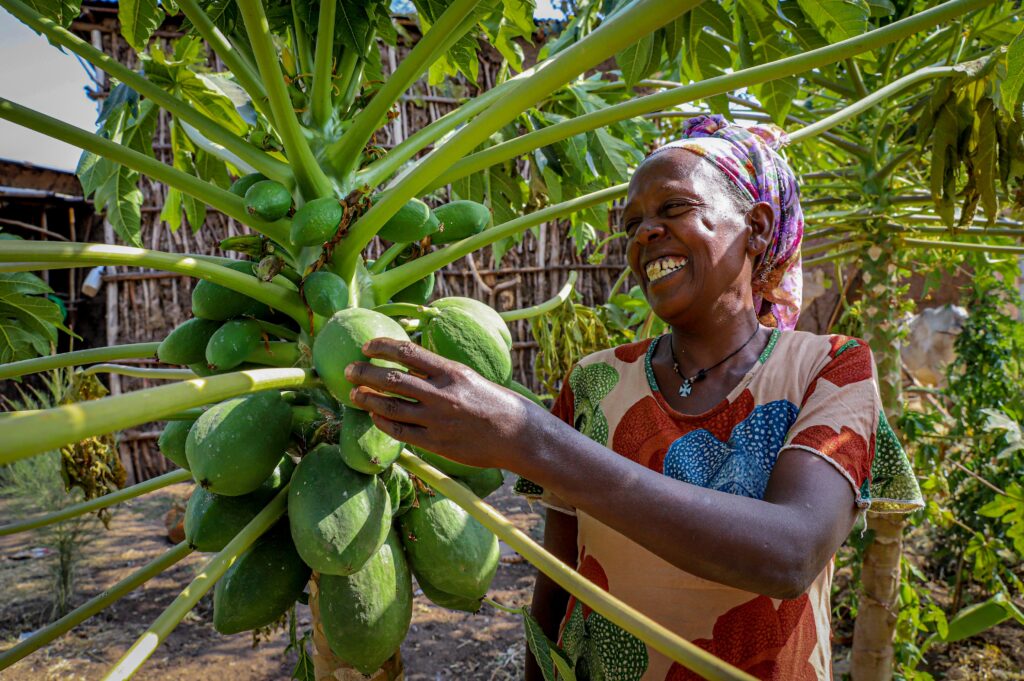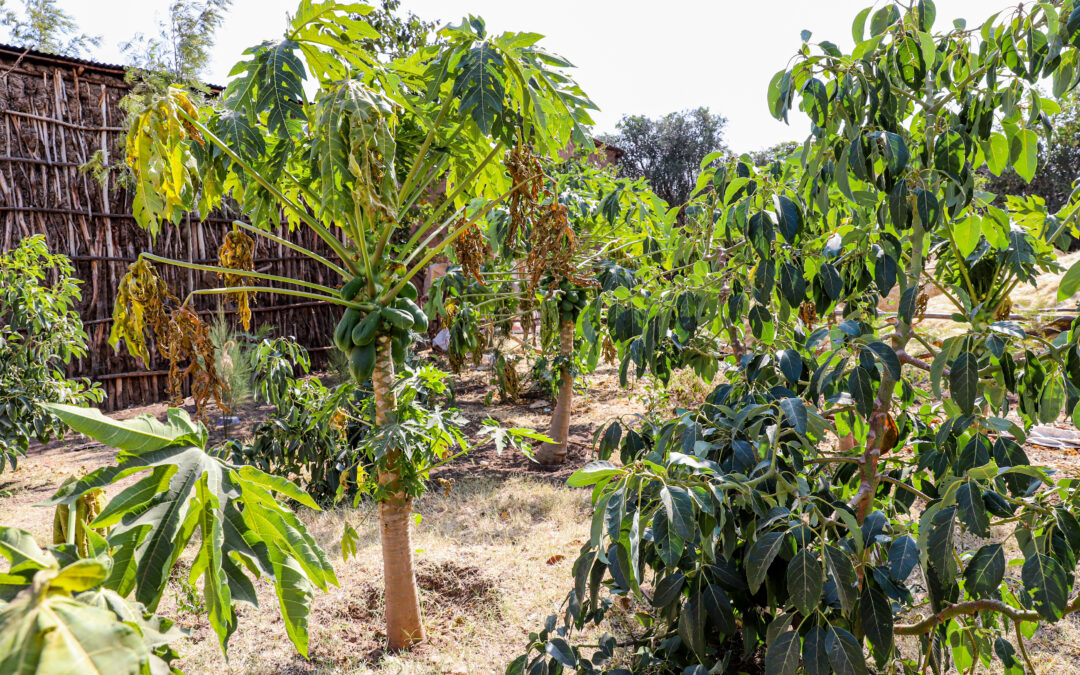By Regreening Africa – CRS Ethiopia
Mrs. Mamitu Kumbi never imagined that her 0.9 hectares of land could be productive enough to produce an abundance of various fruits before 2019.
“This area was bare, unproductive, and only used for waste disposal,” she recalls.
She was hesitant at first when Regreening Africa introduced her to fruit tree farming, but she decided to test the waters before delving deeper into it.
Mrs. Kumbi became aware of the project as a result of community awareness campaigns and consultation meetings. She decided to participate when the project, through Catholic Relief Services (CRS), offered training on home gardening, agroforestry practices, tree planting and management, as well as Farmer Managed Natural Regeneration (FMNR) practises, in close collaboration with the relevant stakeholders.
Her curiosity got the best of her, and as she became more involved with the project team, she was chosen to receive intensive training in agroforestry, fruit and tree seedlings, and soil health management.
After the training, she was given papaya tree seedlings, grafted mangoes and avocadoes, lemon, gesho, and several multipurpose trees like Grevillea robusta, Casuarina equisetifolia, Olea africana, Cordia africana, and Croton macrostachyus. These can be used for firewood and timber, as well as for cattle feeding and shade.
With knowledge gained on fruit tree farming, yet still filled with doubt, she decided to portion a small piece of land, approximately 100 m2, and plant the seedlings.
“I planted papayas and local vegetables, and when I had enough harvest to feed my family, I decided to grow more crops and fruit trees in a bigger area.”
 Mamitu has a fruit garden on her homestead as a source of income and to diversify the household diet. Photo: CRS Ethiopia
Mamitu has a fruit garden on her homestead as a source of income and to diversify the household diet. Photo: CRS Ethiopia
After the first harvest, she realised that the whole plot of land could produce more, and her doubts started to go away. With a renewed resolve, she tilled the remaining piece of land and planted even more fruit trees. She also added gesho and spices such as chilies, garlic, rosemary, mint, basil, and ruda plant (tena-adam). With the proceeds from their sale, she was able to provide for her family.
“I get substantial benefits—from improving my family’s diet to generating income through the sale of gesho seedlings, fodder, timber, and firewood,” she says.
Mrs. Mamitu is able to earn an average annual income of 9600 Ethiopian Birr from the sale of the fruits and crops (about 181 USD).
Seeing what she once thought was bare land produce so much, she decided to share her knowledge and encourage fellow farmers to adopt home gardening as it is less labor-intensive and time-consuming.
She has established a fruit orchard on her 0.9 hectares of land and grows a variety of high-value fruits, cash crops, and multipurpose trees.
“I didn’t expect good results. But now, I’ve been growing fruits for my own consumption as well as selling them at the market. Furthermore, selling the fruits covered my home expenses, allowing me to keep my household assets from being sold.”
Home gardening (fruit orchard) has triggered a mindset change as farmers like Mamitu are able to witness positive changes in their landscape. With the additional income from the sale of the fruits and the nutritional benefits that come with it, communities are now motivated to adopt these regreening practices.
The Regreening Africa Programme is a five- and half-year programme (2017-2023) funded by the European Union that seeks to improve livelihoods, food and nutritional security, resilience to climate change, and ecosystem services through evergreen agriculture. In Ethiopia, the programme is implemented by a consortium of international NGOs, including Catholic Relief Services (CRS) as the country lead and World Vision Ethiopia (WVE) as implementing partners to World Agroforestry (ICRAF).
The Regreening Africa programme in Ethiopia has strengthened coordination and collaboration with government sectors, particularly at the woreda level. The ultimate goal of the programme is to foster a massive, sustained landscape restoration movement with widespread adoption. The project built on the successes of existing restoration programmes, laying the groundwork for a nationwide scale-up.
This story was produced with the financial support of the European Union. Its contents are the sole responsibility of Regreening Africa and do not necessarily reflect the views of the European Union.

